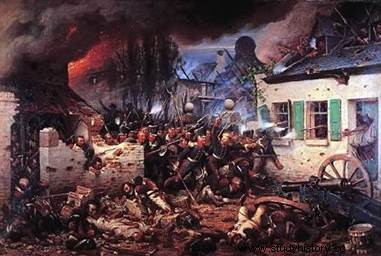
The Battle of Waterloo opposed on June 18, 1815 the armies of Napoleon to the Anglo-Prussian troops of Wellington and Blücher, not far from Brussels. After escaping from the island of Elba where he was being held prisoner, Napoleon returned to Paris on March 20, 1815 and regained power (“Cent-Jours”). Immediately, a coalition formed by Russia, Austria, Prussia and England sent troops to the Belgian border to prepare for the invasion of France. Having gathered an army of 125,000 men, the emperor goes to meet the enemy. The main confrontation, which takes place in Waterloo, ends with a French defeat and the definitive fall of the First Empire.
Why the Battle of Waterloo?
After skilfully avoiding the most royalist regions, the escapee from the island of Elba made a triumphal entry into Paris on March 20, 1815 while Louis XVII and his court win Flanders. Napoleon I gets out of his car, he is carried by the crowd towards the stairs of the Tuileries Palace, the dignitaries of the Empire are there to welcome him, in Paris the tricolor flags stand out from the windows!
However, this momentary enthusiasm should not hide the real difficulties that the Emperor encountered when he returned to power. All the former executives of the Empire have not rushed, the majority of the French remain particularly wait-and-see in the face of this imperial restoration which we do not know if it will be lasting or if it is only an adventure dedicated to the future. 'failure. Napoleon must seek to retain these most dangerous ministers:Fouché recovers his police portfolio. Politically, he must give pledges, not forgetting that it was the Senate that deposed him in 1814.
Napoleon plays the liberalization card, agreeing to let go:freedom of the press is restored and on April 6 his old opponent Benjamin Constant is responsible for drafting a new constitution! In one week, the one who insulted him not long ago in the Journal des Débats , prepared the text that was to frame the new regime: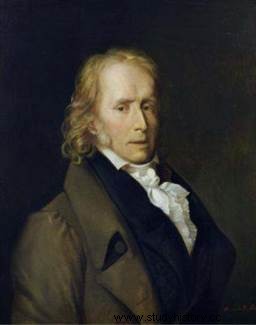 a representative regime, with a broad electoral base, ministers responsible to the chambers... This Supplementary Act to Constitutions de l'Empire truly established a liberal regime and at the end of May the House of Representatives met!
a representative regime, with a broad electoral base, ministers responsible to the chambers... This Supplementary Act to Constitutions de l'Empire truly established a liberal regime and at the end of May the House of Representatives met!
It is accepted massively by plebiscite by 1,500,000 YES against 4,000 NO. Napoleon's objective is simple, to avoid internal opposition (the Vendée is already rising) by rushing the Royalists and the Republicans when it is necessary to concentrate all efforts on the external threat. We find in the Chamber of Representatives former members of the Convention like Barère and other great figures of the Revolution like La Fayette.
At their head:Lanjuinais, an opponent of Napoleon who had been among the first to propose his forfeiture in 1814... The question remains as to whether Napoleon really accepted this loss of power. It is more likely for him a temporary concession on which he hopes to be able to return once the external threat has passed and no one will be able to challenge the victorious Emperor at the head of his army. In this sense, Napoleon needs a quick military victory not only to eliminate the foreign threat, but also to neutralize his political enemies at home.
At the same time, Napoleon must therefore reconstitute an army worthy of the name and reconnect with it and the people. Davout takes charge of the Ministry of War, the soldiers put on leave under the Restoration are recalled, the conscripts of 1815 are raised, the National Guards are called in, the Imperial Guard is reconstituted, the cavalry is reassembled (to the detriment of the Gendarmes who find themselves on foot...) eight army corps are formed and deployed mainly facing the northern and eastern borders. Faced with 700,000 allies, Napoleon hopes to bring together 800,000 men by the end of the year. Napoleon also reconstituted the head of the army, sorting out the Marshals who did not all remain loyal to him. In the end, only Suchet, Ney, Davout, Soult will be there, joined by a newly promoted:Grouchy.
This demonstration of force is accompanied by diplomatic negotiations, Napoleon hopes for a time to detach from the  coalition his father-in-law the Emperor of Austria. Vain hope, Metternich declares that his country “will never treat with Bonaparte”. Another twist of fate, Napoleon lost a weighty ally in Italy:Murat, who sought to redeem himself for his behavior in 1814, set out alone to conquer the peninsula and was beaten by the Austrian armies of Neipperg (Marie-Marie's new lover). Louise...).
coalition his father-in-law the Emperor of Austria. Vain hope, Metternich declares that his country “will never treat with Bonaparte”. Another twist of fate, Napoleon lost a weighty ally in Italy:Murat, who sought to redeem himself for his behavior in 1814, set out alone to conquer the peninsula and was beaten by the Austrian armies of Neipperg (Marie-Marie's new lover). Louise...).
Murat's thoughtless action had a second serious consequence:it shattered the pacifist discourse that Napoleon was trying to convey to the allied powers. Therefore, armed confrontation seems inevitable. We replay 1804, June 1st at the Champ de Mai Napoleon takes part in a great solemn ceremony:the Eagles are distributed, the oath is taken, the Emperor is there, but it is not the little corporal in the cocked hat, it is the monarch in her white satin costume... The expected momentum is not there, the ceremony seems a parody of a bygone era.
Napoleon therefore needed a major victory, to oust an external threat that did not want to negotiate, and to return in force to Paris and impose himself on his political opponents. Several campaign scenarios are envisaged:an attack in April, but not everything is ready, a defensive war around Paris and Lyon, or an offensive in June. It is this last option that is adopted. The Anglo-Dutch are around Brussels, the Prussians around Namur, Russians and Austrians are still too far away to intervene immediately. Attacking in June should allow Wellington and Blücher's Prussians to be surprised before they go on the offensive themselves. A decisive victory against these two armies would not rid Napoleon of the allies (there are still the Austrians and the Russians), but he hoped that it would shock the latter and quickly bring them back to the negotiating table.
In case of failure it is always possible to adopt the defensive strategy on Paris and Lyon. To compensate for this eventuality, fresh troops (25,000 men) were left in Alsace to then face the Austrians. This great caution on the part of Napoleon was sometimes considered a mistake, because not all the living forces of the Empire were used in the Belgian campaign where the main action commanded by the Emperor himself must take place. On June 14, the concentration of forces to march on Belgium is completed, Napoleon has regrouped 124,000 men and 370 guns to face the 95,000 men and 186 guns of Wellington and the 124,000 men and 312 guns of the Prussians whom he intends to beat separately to compensate for its great numerical inferiority.
On June 15, 1815, the French army jostled the enemy detachments around Charleroi and crossed the Sambre in three columns. Napoleon's idea was then to first beat the Prussians who might fall on his flank if he marched on the British who, reacting quickly, decided to rescue the Prussians. Napoleon sends Marshal Ney to Quatre-Bras to contain the British while Grouchy pushes back the Prussian vanguard at Fleurus.
The Battles of Ligny and Quatre-Bras
On the night of June 15-16, the Duke of Wellington understands that the French attack is mainly on the Prussian army. He then sets up a strategy to surprise the French army:the Prussians will have to play the role of the anvil and contain the imperial armies in the region of Ligny. During this time the British army will have to play the role of the hammer and fall on the flanks of the French while passing by the crossroads of Quatre-Bras. Napoleon marched with Grouchy against the Prussians whom they encountered at Ligny.
The weather was hot and heavy, Napoleon launched an attack on the Prussian center and counted on an action by Ney who, after taking Quatre Bras, would fall on the Prussian flank. But the British resisted and Ney did not take Quatre Bras:his late cannonades and cavalry charges (2 p.m.) not supported by the infantry remained ineffective. There remains Erlon's corps, which could have played a major role in this day, but caught between the orders and counter-orders of Napoleon and Ney, Erlon's corps goes back and forth between the two battlefields and does not finally participates in none!...
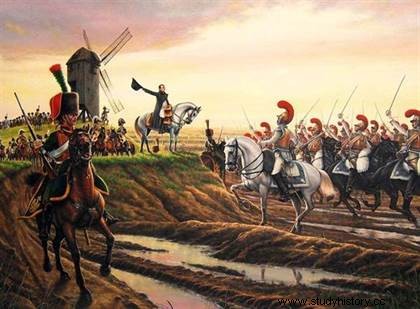
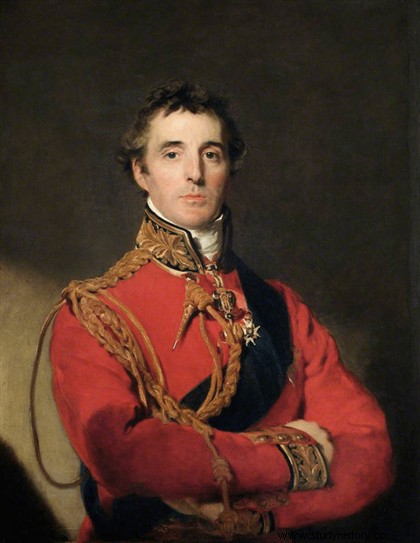 At the end of the day, the Prussians were beaten, but not destroyed, Blücher overthrown by the Imperial Guard and the cuirassiers de Milhaud:Blücher falls to the ground, the French horsemen pass by him without realizing it, he remains stretched out for 10 minutes behind the French lines before reaching his army on a dragon's horse! The Prussian army which lost between 12,000 (according to Houssaye) and 20,000 killed and wounded (6,500 to 8,500 on the French side) then fell back on Wawre while Wellington fell back on the defensive position of Mont-Saint-Jean, the last open ground allowing battle to be fought ahead of Brussels before the Sonian Forest.
At the end of the day, the Prussians were beaten, but not destroyed, Blücher overthrown by the Imperial Guard and the cuirassiers de Milhaud:Blücher falls to the ground, the French horsemen pass by him without realizing it, he remains stretched out for 10 minutes behind the French lines before reaching his army on a dragon's horse! The Prussian army which lost between 12,000 (according to Houssaye) and 20,000 killed and wounded (6,500 to 8,500 on the French side) then fell back on Wawre while Wellington fell back on the defensive position of Mont-Saint-Jean, the last open ground allowing battle to be fought ahead of Brussels before the Sonian Forest.
Later, Napoleon will say that this choice of Wellington was hardly judicious, because in the event of defeat he could not have operated an organized retreat through this forest massif. On the 17th, Napoleon resumed his march, this time towards Mont-Saint-Jean, entrusting Grouchy and his 30,000 men with chasing the Prussians.
Napoleon foresees several possible scenarios, but the instructions remain unclear as to the behavior to adopt. Moreover, Grouchy has few means to know the option that Blücher will actually choose:that of joining Wellington instead of retreating towards his lines of communication (towards the East)... The English rearguard is literally pursued by the French, cannonaded by the artillery, sabered by the cavalry. The weather itself deteriorated, violent storms broke out in the region, soaking the hollow roads and the fields:they were of precious help to the defenders, delaying Napoleon's assault on June 18 and reducing the effectiveness of the French artillery whose balls will sink into the mud instead of ricocheting in the middle of the enemy ranks.
The Defeat of Waterloo
On the day of the battle, the Anglo-Dutch-Belgians had 85,000 men minus the 17,000 detached, or about 68,000 men and 184 guns. The Prussians have 127,000 men. As for the French, they only have 74,000 men and 266 guns.
At dawn on June 18, 1815, the British army was ready for battle. The cautious Wellington put up a defensive formation. He stretched his troops over the 3 km of Mont-Saint-Jean, just behind the ridge line, so that they remained protected from the powerful French artillery. On the ridge is the British artillery, ready to unleash hellfire on any column of infantry that tries to climb the plateau. Finally, to break the momentum of these assault columns, Wellington positioned troops around three castle-farms arranged on the slope:on the British right wing (to the West) the Hougoumont farm, in the center the Haie-Sainte farm and on the left wing (to the east) the Papelotte farm.
About 800m away, to the south, the French army is waking up. Like most of their coalition counterparts the French soldiers have 'slept' under the stars and are soaked. At 8 a.m., Napoleon had lunch at Le Caillou with his staff. Reille, who had fought in Spain, knew Wellington's strategy of betting everything on firepower thanks to very stretched infantry lines:he strongly advised against a frontal attack. . Napoleon's plan, however, provides for a frontal attack:it is a matter of waiting for the ground soaked by the storms to dry out a little to launch an attack on the center after a powerful artillery preparation. The weather quickly becomes again, as in Ligny, hot and heavy.
At 11:30 a.m. only the cannonade began, not very effective in truth since the French guns were far (1,200m) from their objective and the majority of the British troops were protected by the ridge. The order is then given to seize the Hougoumont farm, to divert the attention of the British army before attacking the center:the division of Prince Jérôme, Napoleon's brother, goes to the assault . The fight is fierce, the position is defended by a Highlander, Lieutenant-Colonel James Macdonnell commanding 200 Coldstream Guard and 1,000 Germans from Nassau! The farm is surrounded by a 2m high wall that the defenders have pierced with loopholes:it's a real fortress!
The Germans are driven out of the orchards surrounding the farm, Lieutenant Legros of the 1st Light even manages to break down the southern door with an ax and enter the enclosure with a handle of comrade:unfortunately for them the defenders manage to reblock the exit and massacre the few Frenchmen who have already entered... Wellington sends reinforcements to defend the farm and the French left wing is uselessly exhausted trying to take this secondary objective. 5,000 French perished in these assaults while the defenders lost "only" a thousand men. In front of the surrounding wall of the farm is a pile of corpses that the British nicknamed the "killing ground .
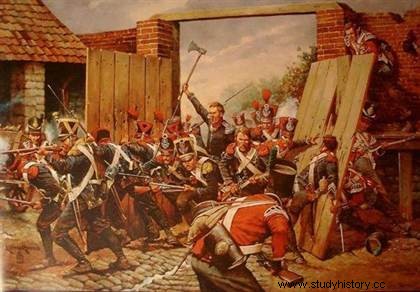
Napoleon then enters the second phase of the battle:pushing through the enemy center. The first Prussian units are already in sight and Napoleon sends the order to return to Grouchy. At 1:30 p.m. the assault on the center began with a violent artillery duel before the French infantry mounted the assault, forcing the Dutch-Belgians present on the slope to withdraw to the plateau and the defenders of La Haie -Holy to barricade herself in the farm. General d'Erlon, who knows Wellington's strategy based on firepower, avoids having his troops mount in compact columns and arranges them in long lines. General Durutte even reached the Papelotte farm, threatening Wellington's left wing.
The French assault was however stopped on the ridge by British (veterans of the Spanish Civil War) and Hanoverian troops who machine-gunned the grognards breathless from the ascent of the plateau. General Picton even tries a counter-attack, but collapses, swept away by a bullet in the head. To secure this left wing, Wellington launched his cavalry into the fray:the 1st and 2nd Life-Guard accompanied by Ponsomby's Dragoons who swooped down on the Marcognet division and pushed it back. Nevertheless, the British cavalry did not shine by its discipline, caught in their momentum the Scots-Greys continued their charge despite the order to withdraw, managing to saber the French artillery before being taken in pincers by the lancers of Martigues and the Cuirassiers of Travers:General Ponsomby was wounded by a spear (he survived the battlefield and even received help from a French soldier) and the British cavalry suffered heavy losses.
The French assault on the center having failed, the battle entered a third phase around 3:30 p.m.:French artillery bombarded La Haie-Sainte to prepare an assault. Seeking to protect themselves, some enemy battalions withdrew, which Ney misinterpreted as a vast retreat. He then decided to overthrow the enemy with massive cavalry assaults from 4 p.m.:the Cuirassiers of Milhaud, closely followed by the Chasseurs à Cheval of the Guard, charged the enemy centre. Seeing this glittering mass of breastplates approaching, Wellington's center and right wing formed thirty squares in four ranks offering walls of bayonets to the centaurs of the Empire.
Placed in front of the squares, the British artillery greeted the French cavalry with devastating shots of grapeshot, followed by the salvoes of the infantrymen encouraged to hold by their officers shouting at each other in the center squares. The enemy batteries are overwhelmed, but the guns are not nailed... The squares resist despite the relentless assaults led by Ney for two hours. In the end, these heroic charges were a murderous failure, and Napoleon was sometimes criticized for not having launched the infantry in support of Ney's cavalry. Pursuing the retreating French, the remnants of the British cavalry commanded by Uxbridge chase the French.

The French infantry is not inactive, however, far from it! To the south-east, the French infantry had to face the Prussians of Bülow who were entering the rear of the imperial army! This bad news is kept secret on the front line, on the contrary the imminent arrival of Grouchy is announced. Napoleon must send the corps of Lobau to contain the Prussians, at 6 p.m. fighting rages in the village of Plancenoit and Napoleon must bring in the Young Guard supported by two battalions of the Old Guard:Plancenoit is taken over by the French! Napoleon then ordered Ney to seize Haie-Sainte at all costs:Quiot and his men attacked the Sainte farm and managed to seize it when the defenders ran out of ammunition. The capture of the farm makes it possible to approach the French artillery and to carry out murderous fire on the British center.
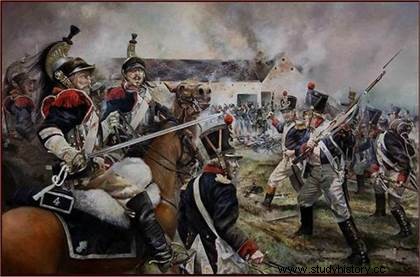
At the same time, Durutte mishandled the British left wing. Wellington is in a very bad position, his line of defense threatens to give way, his cavalry is decimated, ammunition is running out and the Cumberland Hussars have even left the battlefield! In this critical situation the British general would then have declared:“I need the night or the Prussians! ". If night is still far away, the Prussian threat is very real for Napoleon:the situation on 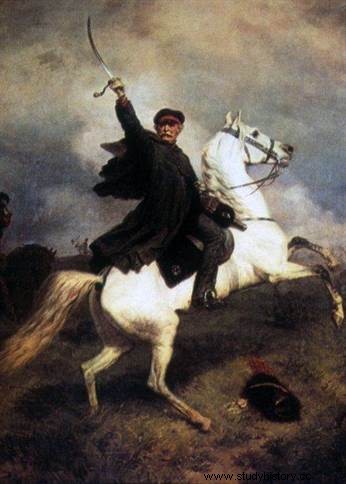 place becomes critical and immobilizes many troops, preventing the Emperor from sending the reinforcements that Ney constantly requests. Napoleon arranges his troops in a square along the road to Brussels and sends the Guard to extricate Plancenoit.
place becomes critical and immobilizes many troops, preventing the Emperor from sending the reinforcements that Ney constantly requests. Napoleon arranges his troops in a square along the road to Brussels and sends the Guard to extricate Plancenoit.
Napoleon then had two options:withdraw using his Guard to cover the retreat, or play all his pawns in a final assault. Given the absolute necessity of a victory, politically and strategically, Napoleon can only really try the second option. At 7 p.m. the final assault begins, nine Guards battalions must mount the plateau and drive out the enemy. At the same time, Wellington hurried to reinforce his center with all available reserves. Ney made these attack columns pass by the same route as the cavalry, very exposed to artillery, whereas the road to Brussels would certainly have been less dangerous. Well trained, the Guard progresses in order to the ridge. Facing the 5th Brigade, the Grognards suffer a murderous salvo, they stop, retaliate, and push back the defenders.
The English line is then on the verge of being broken through, but the second line composed of Dutch restores the situation. The Guard is mowed down on its flank by the grapeshot of the British artillery and the salvo fire which resumes:for the first time in its history the Imperial Guard retreats. Facing the British Guard, the rest of the Guard also fails to fulfill its mission, it is mowed down by salvos released at around 25m. On the left of the French attackers Colonel John Colborne deployed his men in a long line with a clear field of fire which decimated the Imperial Guard.
Panic invaded the French ranks with cries of “The Guard is back! », all converged towards the foot of the plateau and Wellington ordered his troops to march forward to take advantage of this rout. Ney, who had already had five horses killed under him during the battle, harangued the infantrymen of the 95th:“Come and see a Marshal of France die! ". Napoleon is a hundred meters from Haie-Sainte with three battalions of the Old Guard, desperate he would have sought to die on the battlefield as reported by several memorialists such as the famous Jean-Roch Coignet.
Resigned, Napoleon ordered to fall back in the direction of the Belle Alliance. In the middle of the 2nd battalion of the 2nd hunter, Cambronne stands up to the English and throws out his famous word! Plancenoit still held out, but two battalions could not stand up to two army corps indefinitely... Napoleon ordered a retreat. Only the Old Guard retreated in good order, in step, formed in two squares. At 9 p.m. the Prussians were masters of Plancenoit, Blücher and Wellington made their junction at Belle Alliance. Moreover Blücher would have liked this name to become that of the battle, but Wellington will impose the village of Waterloo, the place where his headquarters are located.
For Napoleon, Waterloo was an irretrievable failure. It has sometimes been invoked his degraded state of health, his hemorrhoids which prevented him from riding as he pleased to reconnoitre the terrain and show himself to men. But of course, with regard to the course of the battle, these elements cannot be sufficient to explain the defeat. The retreat turns into a disaster, the Emperor's sedan is captured, with its ceremonial coat, its treasure, one of its hats... On the Prussian side, the instructions are clear:no prisoners! The French army lost 7 generals and 20,000 killed and wounded. On the opposing side, the losses are roughly equivalent:20,000 killed and wounded, including 7,000 Prussians. What remains of the French army moves towards Charleroi then marches towards Paris via Laon.
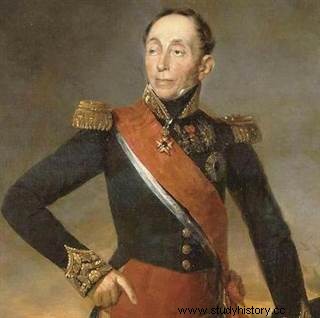 What was Grouchy doing?
What was Grouchy doing?
Grouchy was often the designated scapegoat to justify defeat. He was reproached for his lack of experience, his lack of responsiveness, his lack of initiative... He was reproached for having obeyed orders when Gérard asked him to march to the cannon... Saint-Jean, Grouchy was trying to catch up with Blücher's army. He confronts the Prussians at Wavre and thus thinks to fully fulfill his mission by keeping them away from the British. In reality, Grouchy did not have the four Prussian corps facing him, but only one, that of Thielmann left behind, entrenched behind the Dyle swollen by violent storms. He only realizes it late on this decisive day, around 6 p.m....
Solidly barricaded in the town of Wavre, Thielmann succeeded perfectly in his mission:to keep Grouchy away from the battlefield of Waterloo. Grouchy did receive a new order on the 18th, however, the order transmitted to him is unclear (he orders both to continue the fight at Wavre and to pursue the Prussians towards Waterloo...), writes in pencil, partly illegible, no one can read whether the battle at Waterloo is "engaged" or "won"... The order sent at 1 a.m. would have taken 3 hours to reach Grouchy, some think that the Marshal In any case, he would not have had time before the end of the battle to cover the fifteen kilometers that separated him from Napoleon.
Once the defeat at Waterloo had been consummated, Grouchy received the order to fall back towards France via Namur. It is to the honor of this Marshal to have succeeded in bringing his body intact to French territory.
Military defeat leads to political defeat 
Napoleon hopes to gather men in about ten days to organize the defense. If the corps of Grouchy, Rapp and the Army of the Loire quickly rallied Napoleon, he hoped to bring together 80,000 to 100,000 men. Enough to hold back the coalition a little while organizing a big levy to have a total of 800,000 men under the flag! However, in his constitutional empire, he needs the vote of the deputies to raise new contributions in men and money. He does not know that having learned of the defeat on June 19, Fouché is already trying to convince the deputies that Napoleon must give up power...
While Grouchy was still fighting at Wavre, Napoleon reorganized his army as much as possible around Philippeville and gave command to Soult before going to prepare the defense of Paris, because it is only by being there that he will be able to impose his views on the deputies.
In addition to the operations in Belgium, the Imperial troops are victorious against the Vendée rebels and in the East Marshal Suchet has pushed back the Piedmontese and is marching on Geneva. All does not seem lost. But Napoleon, despite the political skill of his brother Lucien, was unable to retain the confidence of the Chambers. He tries in vain to get the dictatorship to manage this end of the campaign.
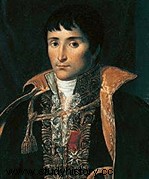 Dissolving the Chambers is the only solution according to Lucien, but Napoleon refuses to do so, the Chamber herself declared that any attempt to dissolve it would be a crime of high treason.
Dissolving the Chambers is the only solution according to Lucien, but Napoleon refuses to do so, the Chamber herself declared that any attempt to dissolve it would be a crime of high treason.
Carnot urges the Emperor to declare the Fatherland in danger, to call in the National Guards, to recover the momentum of 1792 and 1793, to take refuge behind the Loire to regroup the forces before counter-attacking. Caulaincourt on the contrary explains that if Paris falls all is lost. There is still a fervent patriotic spirit, a fierce spirit of resistance in the departments of the North and the East where 16-year-old college students form artillery companies, where units of snipers like the corps francs of Colonel Viriot which display the black flag with a skull and crossbones bearing the inscription "The Terror is ahead of us. Death follows us. Even in traditionally more refractory regions such as Puy-de-Dôme, there are outbursts of patriotic support:buyers of national property provide harnessed horses.
France seems to be able to rise up in one block, to become a hornet's nest for the coalition army as Spain had been for the Grande Armée. However, the general uprising was a double-edged sword, the federal associations which were formed, in the spirit of Year II, brought together Bonapartists but also "Patriots of 1789" and "Terrorists of 1793" all united to block the return of the Bourbons but not all of them necessarily loyal to the imperial monarchy. Cries of “Long live the Republic!” cross those of “Vive l’Empereur!” ", we go in places to attack the ci-devant, we even sometimes want to replant trees of freedom... It is the return of old revolutionary reflexes paradoxically incompatible with the Empire.
Moreover, this commotion hides the real situation of the country, the extreme wait-and-see attitude of the majority of French people, tired of the wars of the Revolution and the Empire, the desire for a rapid return to peace. De nombreuses régions rechignent à mobiliser des gardes mobiles :l'Ariège, la Haute-Loire, l'Oise... La vérité est que la France de 1815 n'est pas celle de 1792, échaudés par 1814 les paysans fuient devant l'avance coalisée, les villes n'opposent pas de farouche résistance. Pire, une partie de la population est ouvertement royaliste, et pas qu'en Vendée. En secret, des  royalistes préparent déjà le tyrannicide, en province des nobles vont jusqu'à soudoyer les soldats mobilisés, certains commerçants espèrent un retour du Roi pour rétablir un commerce fructueux avec l'Angleterre.
royalistes préparent déjà le tyrannicide, en province des nobles vont jusqu'à soudoyer les soldats mobilisés, certains commerçants espèrent un retour du Roi pour rétablir un commerce fructueux avec l'Angleterre.
Face à ce manque de soutien populaire Napoléon n'a pas les moyens d'imposer les levées par la force :l'épuration politique des Cent-Jours a porté dans les départements des Préfets inexpérimentés ou du moins qui n'ont pas encore eu le temps de connaitre leur département, dans les communes beaucoup de maires royalistes sont restés en place.
Napoléon est dans l'impasse politique, Fouché prépare déjà l'après-Empire. Plus hostile que jamais, la Chambre des représentants finit par s'octroyer illégalement les pouvoirs régaliens poussant l'Empereur à l'abdication ou au coup d'État. Face au danger de la guerre civile, et malgré le soutien d'une partie de la population parisienne venue manifester son soutien aux abords de l'Élysée, Napoléon ne voulant pas être « le roi d'une jacquerie » se résigne à abdiquer le 22 juin 1815, il se retire à La Malmaison après avoir dicté une déclaration au peuple français.
Un gouvernement provisoire prend alors les rennes de la France avec à sa tête Carnot, Grenier, Caulaincourt, Quinette et pour les présider :Fouché ! Napoléon II est bien proclamé, mais Fouché négocie avec les Anglais la capitulation de Paris et le retour des Bourbons.
Les derniers combats
La marche des coalisés sur Paris est parsemée de combats, parfois favorables aux Français, mais souvent tombés dans l'oubli, car peu important stratégiquement et restant dans l'ombre de l'hécatombe de Waterloo. Le 20 juin, Grouchy bat les Prussiens qui le talonnaient d'un peu trop près.
Le 26 les coalisés s'emparent de la forteresse de Quesnoy défendue par les Gardes Nationaux. Le 27 à Compiègne, d'Erlon bat les Prussiens de Ziethen tandis qu'à l'inverse Bülow s'impose à Senlis et à Creil. Le 28 les coalisés s'imposent sur tous les fronts et ne sont plus qu'à une cinquantaine de kilomètres de la capitale française que Blücher décide d'attaquer par le Nord le 30 juin. Blücher est repoussé par les défenseurs de Paris, il se redéploie à l'Ouest et au Sud de la capitale.
Dans Paris, Davout ne manque pas de vivres et de munitions, il sait qu'il peut tenir tête à Blücher mais est aussi tout à fait conscient qu'à moyen terme la Restauration de Louis XVIII s'impose. Pour calmer les ardeurs des Prussiens il envoie toutefois contre eux le 2e corps de cavalerie d'Exelmans. Seize escadrons de Dragons, six escadrons de Hussards, huit escadrons de Chasseurs à Cheval et quatre bataillons du 44e régiment d'infanterie de Ligne font une sortie.
Bénéficiant d'une forte supériorité numérique (sept contre un, environ 5.000 contre 750), Exelmans fond par surprise sur la brigade du colonel Sohr vers Vélizy et l'oblige à se replier sur Rocquencourt où il l'écrase. Le colonel Sohr est tué durant la bataille, 300 de ses hommes sont fait prisonniers. La défaite de l'avant-garde prussienne à Rocquencourt est considérée comme la dernière bataille de la campagne dite de Belgique, un dernier baroud d'honneur qui n'empêche pas la signature d'un armistice trois jours plus tard. Les combats en France ne s'arrêtent pas pour autant, il faut attendre le 15 novembre 1815 pour que le général Daumesnil accepte de rendre le château de Vincennes.
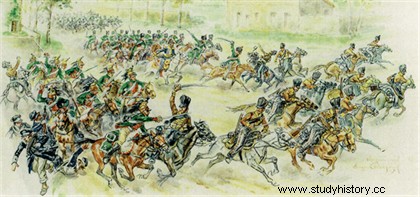
Napoléon quant à lui, après avoir en vain proposé de prendre comme simple général la tête de l'armée de la Commision de gouvernement, se rend à Rochefort. Il espère un temps pouvoir s'exiler en Amérique, mais le 3 juillet il apprend que les sauf-conduits lui sont refusés et que la flotte britannique bloque la côte. Conscient que Fouché risque de la livrer aux royalistes, Napoléon se remet entre les mains des Anglais qu'il espère plus cléments. Le 8 juillet Louis XVIII fait son entrée à Paris, Napoléon attend alors sur l'île d'Aix. Le 14 juillet il monte à bord du Bellérophon qui fait voile vers Plymouth puis vers la dernière demeure de l'Empereur déchu :l'île de Sainte-Hélène.
Waterloo entre dans la légende 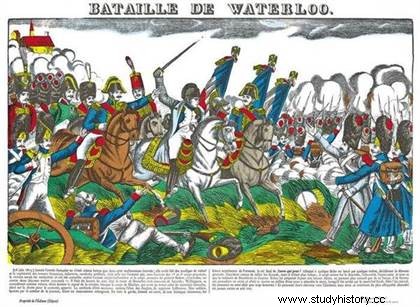
Waterloo devint très rapidement un symbole, commémoré par les acteurs mêmes de la bataille. Ainsi, Wellington organisa toute sa vie un banquet le 18 juin pour porter un toast à la victoire. Le dernier eut lieu en 1857. De nombreux bâtiments publics comme des casernes ou la fameuse gare londonienne portèrent également le nom de Waterloo.
Côté français l'ultime bataille fait couler autant d'encre qu'elle fit couler de sang. Ce sont d'abord les acteurs de la bataille comme Marbot qui couchent sur le papier leurs mémoires de campagne. Mais c'est aussi Napoléon lui-même qui livre son récit de son projet politique avorté dans les plaines belges à travers le Mémorial de Sainte-Hélène publié en 1823. L'ouvrage devient le livre de chevet d'une génération de jeunes romantiques désabusés par la platitude d'une époque qui parait bien fade comparée à la grande épopée impériale digne des plus grandes tragédies antiques.
Ceux qui n'ont pas eu l'occasion de participer à la geste napoléonienne la chantent en vers en prose, incités bientôt par une Monarchie de Juillet qui cherche à capter à son profit la commémoration de la gloire impériale et organise le retour des Cendres de l'Empereur en 1840. Romantiques et réalistes ne cessent les références à la bataille de Waterloo, sorte de Thermopyles à la française pleine de fureur, de panache et de frustration.
En 1839, on retrouve dans La Chartreuse de Parme de Stendhal le jeune Fabrice del Dongo, guidé par une vivandière, assiste à la bataille de Waterloo et voit passer l'escorte de l'Empereur. François-René de Chateaubriand rendant son âme à Dieu en 1848, ses Mémoires d'outre-tombe commencent à être publiés dès l'année suivante. Bien qu'ardent royaliste, le tourmenté Chateaubriand demeure un fervent admirateur de Napoléon et a raconté la façon dont il vécu la bataille de Waterloo, lui qui avait accompagné Louis XVIII dans sa fuite.
Victor Hugo, la grande figure littéraire qui succède à Chateaubriand, reprend vivement le flambeau de la mémoire napoléonienne. En 1853, exilé après le coup d'État de Napoléon III il écrit certainement dans Les Châtiments les plus belles lignes, et en tout cas les plus célèbres sur la funeste bataille :
Waterloo plane sur l'œuvre comme un fantôme du passé, notamment sur le sombre couple des Thénardier, tenant la fameuse auberge « Au sergent de Waterloo » ! Hugo, qui avait fait la démarche d'aller visiter les lieux, parlera encore de la bataille « où l'on vit choir l'aigle indompté » dans La Légende des siècles où il inclut le poème « Le Retour de l'Empereur ». Ces notes et impressions lors de sa visite du champ de bataille en 1861 sont même reportées dans ses Choses vues.
En 1865, en plein Second Empire, Erckmann et Chatrian publient leur roman historique à succès :Waterloo , qui fait suite à l'Histoire d'un conscrit de 1813 . Suivant les pas des troupiers, ils donnent à ce roman une touche à la fois épique et authentique selon un style que l'on qualifie parfois de réalisme rustique maintenant en scène des personnages simples et familiers devenus malgré eux héros de l'épopée.
Balzac envisageât d'écrire une histoire des batailles napoléoniennes, et plus généralement le mythe tragique de Waterloo bénéfice de l'apothéose poétique dont bénéficie Napoléon sous la plume de grands auteurs aux opinions politiques diverses :Nerval, Pouchkine, Lamartine... Ou encore le célèbre chansonnier Béranger qui influence beaucoup la culture populaire !
La culture populaire se forge aussi à grands coups de gravures et d'images d'Épinal qui se diffusent très largement partout en France. La vision qui en est donnée de la bataille de Waterloo est souvent assez binaire avec deux thèmes principaux :Napoléon vaincu cherchant la mort, mais retenu par ses généraux, et le dernier carré de la Garde Impériale tenant héroïquement tête aux Anglais avec souvent en bonne posture le Général Cambronne répondant à la demande de reddition :« La Garde meurt, mais ne se rend pas ! » puis, devant l'insistance des Britanniques :« Merde ! ". Dans les faits, le Général Cambronne refuse toujours de reconnaitre qu'il avait prononcé cette phrase. Il faut dire qu'elle aurait pu paraitre décalée puisque Cambronne n'est pas mort à Waterloo et fut capturé (grièvement blessé toutefois). Et puis il faut dire que le mot de Cambronne n'aurait pas forcément plu à celle qu'il épousa en 1819 :Marie Osburn, une prude veuve écossaise... Finalement, la légende du mot de Cambronne serait peut-être une invention de journaliste reprise et popularisée par Hugo dans Les Misérables :
« Dire ce mot, et mourir ensuite. Quoi de plus grand ! car c'est mourir que de le vouloir, et ce n'est pas la faute de cet homme, si, mitraillé, il a survécu. »
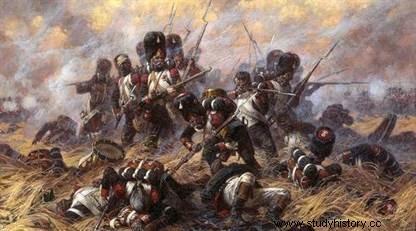
Bibliography
- Waterloo de Alessandro Barbero. Champs histoire, 2008.
- Waterloo :1815, de Thierry Lentz.
- La Bataille de Waterloo de Jean-Claude Damamme. Tempus, 2003.
- Dictionnaire des batailles de Napoléon :1796-1815 de Alain Pigeard. Tallandier, 2004.
